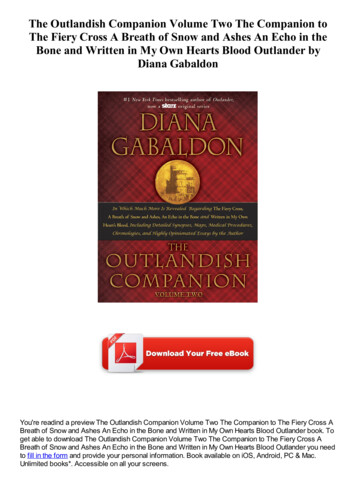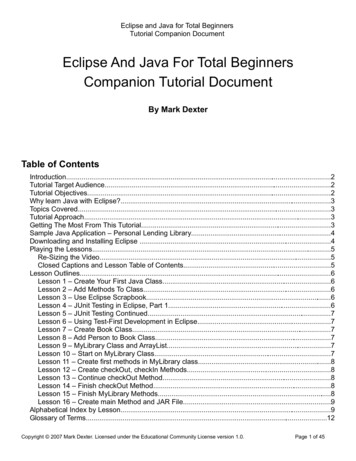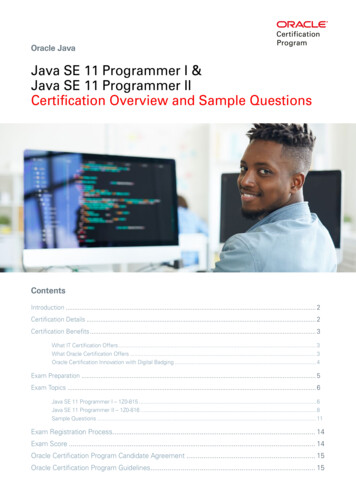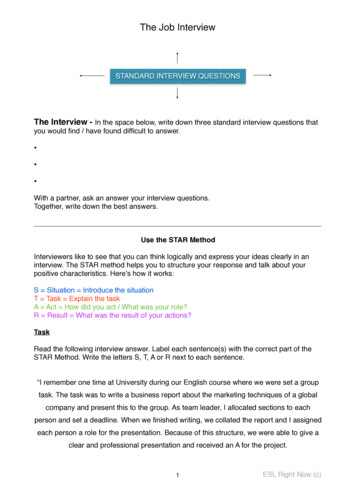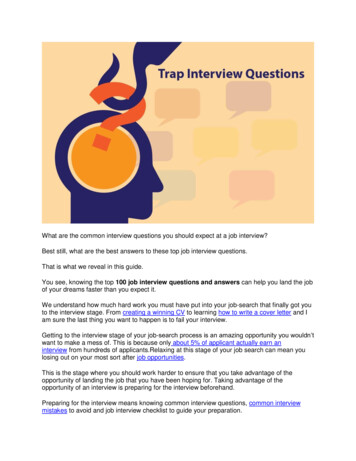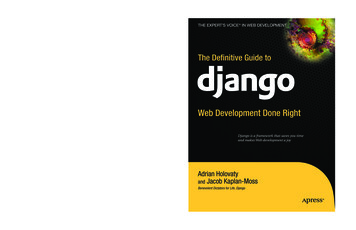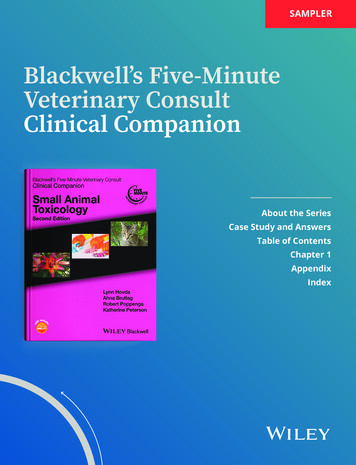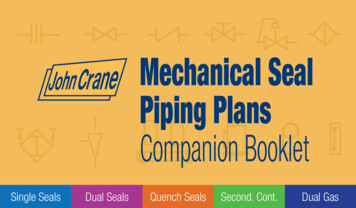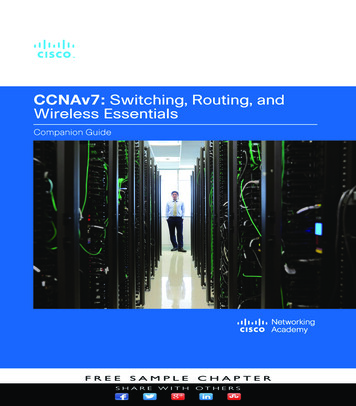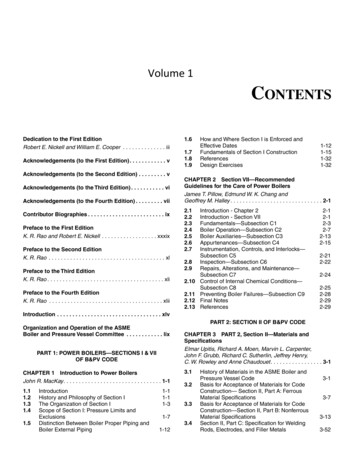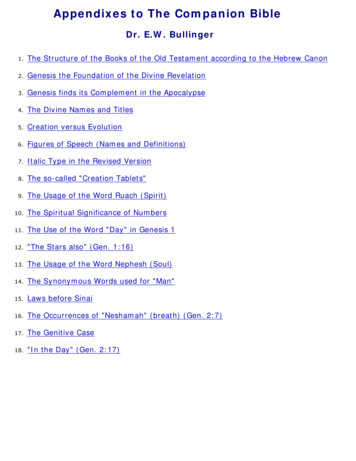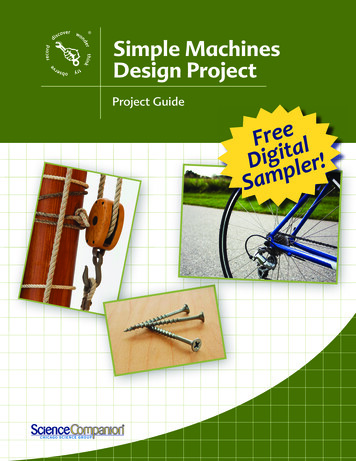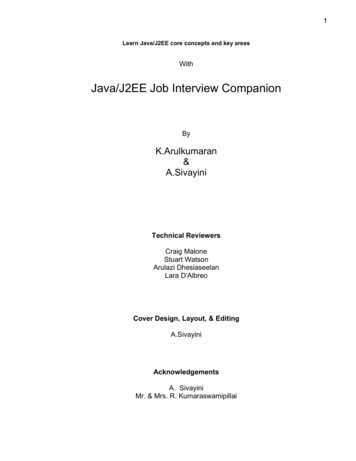
Transcription
1Learn Java/J2EE core concepts and key areasWithJava/J2EE Job Interview CompanionByK.Arulkumaran&A.SivayiniTechnical ReviewersCraig MaloneStuart WatsonArulazi DhesiaseelanLara D’AlbreoCover Design, Layout, & EditingA.SivayiniAcknowledgementsA. SivayiniMr. & Mrs. R. Kumaraswamipillai
2Java/J2EEJob Interview CompanionCopy Right 2005-2007 ISBN 978-1-4116-6824-9The author has made every effort in the preparation of this book to ensure the accuracy of the information. However,information in this book is sold without warranty either expressed or implied. The author will not be held liable for anydamages caused or alleged to be caused either directly or indirectly by this book.Please e-mail feedback & corrections (technical, grammatical and/or spelling) tojava-interview@hotmail.comFirst Edition (220 Q&A): Dec 2005Second Edition (400 Q&A): March 2007
3OutlineSECTIONDESCRIPTIONWhat this book will do for you?Motivation for this bookKey Areas indexSECTION 1Interview questions and answers on:Java SECTION 2FundamentalsSwingAppletPerformance and Memory issuesPersonal and Behavioral/SituationalBehaving right in an interviewKey PointsInterview questions and answers on:Enterprise Java SECTION 3J2EE OverviewServletJSPJDBC / JTAJNDI / LDAPRMIEJBJMSXMLSQL, Database, and O/R mappingRUP & UMLStrutsWeb and Application servers.Best practices and performance considerations.Testing and deployment.Personal and Behavioral/SituationalKey PointsPutting it all together section.How would you go about ?1.How would you go about documenting your Java/J2EE application?2.How would you go about designing a Java/J2EE application?3.How would you go about identifying performance problems and/or memory leaks in your Javaapplication?4.How would you go about minimizing memory leaks in your Java/J2EE application?5.How would you go about improving performance of your Java/J2EE application?6.How would you go about identifying any potential thread-safety issues in your Java/J2EEapplication?7.How would you go about identifying any potential transactional issues in your Java/J2EE
4application?8.How would you go about applying the Object Oriented (OO) design concepts in your Java/J2EEapplication?9.How would you go about applying the UML diagrams in your Java/J2EE project?10. How would you go about describing the software development processes you are familiar with?11. How would you go about applying the design patterns in your Java/J2EE application?12. How would you go about designing a Web application where the business tier is on a separatemachine from the presentation tier. The business tier should talk to 2 different databases and yourdesign should point out the different design patterns?13. How would you go about determining the enterprise security requirements for your Java/J2EEapplication?14. How would you go about describing the open source projects like JUnit (unit testing), Ant (buildtool), CVS (version control system) and log4J (logging tool) which are integral part of mostJava/J2EE projects?15. How would you go about describing Service Oriented Architecture (SOA) and Web services?SECTION 4SECTION 5Emerging Technologies/Frameworks Test Driven Development (TDD). Aspect Oriented Programming (AOP). Inversion of Control (IoC) (Also known as Dependency Injection). Annotations or attributes based programming (xdoclet etc). Spring framework. Hibernate framework. EJB 3.0. JavaServer Faces (JSF) framework.Sample interview questions Java Web Components Enterprise Design GeneralGLOSSARY OF TERMSRESOURCESINDEX
5Table of contentsOutline 3Table of contents 5What this book will do for you? 7Motivation for this book 8Key Areas Index 11Java – Interview questions & answers 13Java – Fundamentals 14Java – Swing 69Java – Applet 76Java – Performance and Memory issues 78Java – Personal and Behavioral/Situational 83Java – Behaving right in an interview 89Java – Key Points 91Enterprise Java – Interview questions & answers 94Enterprise - J2EE Overview 95Enterprise - Servlet 108Enterprise - JSP 126Enterprise – JDBC & JTA 145Enterprise – JNDI & LDAP 155Enterprise - RMI 159Enterprise – EJB 2.x 163Enterprise - JMS 180Enterprise - XML 190Enterprise – SQL, Database, and O/R mapping 197Enterprise - RUP & UML 206Enterprise - Struts 214Enterprise - Web and Application servers 218Enterprise - Best practices and performance considerations 222Enterprise – Logging, testing and deployment 225Enterprise – Personal and Behavioral/Situational 228Enterprise – Software development process 230Enterprise – Key Points 233How would you go about ? 238Q 01:How would you go about documenting your Java/J2EE application? FAQ 239Q 02:How would you go about designing a Java/J2EE application? FAQ 240Q 03:How would you go about identifying performance and/or memory issues in your Java/J2EE application? FAQ 243Q 04:How would you go about minimizing memory leaks in your Java/J2EE application? FAQ 244Q 05:How would you go about improving performance in your Java/J2EE application? FAQ 244Q 06:How would you go about identifying any potential thread-safety issues in your Java/J2EE application? FAQ 245Q 07:How would you go about identifying any potential transactional issues in your Java/J2EE application? FAQ 246
6Q 08:How would you go about applying the Object Oriented (OO) design concepts in your Java/J2EE application? FAQ247Q 09:How would you go about applying the UML diagrams in your Java/J2EE project? FAQ 249Q 10:How would you go about describing the software development processes you are familiar with? FAQ 251Q 11:How would you go about applying the design patterns in your Java/J2EE application? 253Q 12:How would you go about designing a Web application where the business tier is on a separate machine from thepresentation tier. The business tier should talk to 2 different databases and your design should point out the differentdesign patterns? FAQ 286Q 13:How would you go about determining the enterprise security requirements for your Java/J2EE application? 287Q 14:How would you go about describing the open source projects like JUnit (unit testing), Ant (build tool), CVS(version control system) and log4J (logging tool) which are integral part of most Java/J2EE projects? 292Q 15:How would you go about describing Service Oriented Architecture (SOA) and Web services? FAQ 299Emerging Technologies/Frameworks 311Q 01:What is Test Driven Development (TDD)? FAQ 312Q 02:What is the point of Test Driven Development (TDD)? What do you think of TDD? 313Q 03:What is aspect oriented programming (AOP)? Do you have any experience with AOP? 313Q 04:What are the differences between OOP and AOP? 317Q 05:What are the benefits of AOP? 317Q 06:What is attribute or annotation oriented programming? FAQ 317Q 07:What are the pros and cons of annotations over XML based deployment descriptors? FAQ 318Q 08:What is XDoclet? 319Q 09:What is inversion of control (IoC) (also known more specifically as dependency injection)? FAQ 319Q 10:What are the different types of dependency injections? FAQ 321Q 11:What are the benefits of IoC (aka Dependency Injection)? FAQ 322Q 12:What is the difference between a service locator pattern and an inversion of control pattern? 323Q 13:Why dependency injection is more elegant than a JNDI lookup to decouple client and the service? 323Q 14:Explain Object-to-Relational (O/R) mapping? 323Q 15:Give an overview of hibernate framework? FAQ 324Q 16:Explain some of the pitfalls of Hibernate and explain how to avoid them? Give some tips on Hibernate bestpractices? FAQ 333Q 17:Give an overview of the Spring framework? What are the benefits of Spring framework? FAQ 334Q 18:How would EJB 3.0 simplify your Java development compared to EJB 1.x, 2.x ? FAQ 337Q 19:Briefly explain key features of the JavaServer Faces (JSF) framework? 339Q 20:How would the JSF framework compare with the Struts framework? How would a Spring MVC framework comparewith Struts framework? 341Sample interview questions 344Java 345Web components 345Enterprise 345Design 347General 347GLOSSARY OF TERMS 348RESOURCES 350INDEX 352
7What this book will do for you?Have you got the time to read 10 or more books and articles to add value prior to the interview? This book has beenwritten mainly from the perspective of Java/J2EE job seekers and interviewers. There are numerous books and articleson the market covering specific topics like Java, J2EE, EJB, Design Patterns, ANT, CVS, Multi-Threading, Servlets, JSP,emerging technologies like AOP (Aspect Oriented Programming), Test Driven Development (TDD), Dependency InjectionDl (aka IoC – Inversion of Control) etc. But from an interview perspective it is not possible to brush up on all these bookswhere each book usually has from 300 pages to 600 pages. The basic purpose of this book is to cover all the coreconcepts and key areas, which all Java/J2EE developers, designers and architects should be conversant with to performwell in their current jobs and to launch a successful career by doing well at interviews. The interviewer can also use thisbook to make sure that they hire the right candidate depending on their requirements. This book contains a wide range oftopics relating to Java/J2EE development in a concise manner supplemented with diagrams, tables, sample codes andexamples. This book is also appropriately categorized to enable you to choose the area of interest to you.This book will assist all Java/J2EE practitioners to become better at what they do
SECTION 1 Interview questions and answers on: Java Fundamentals Swing Applet Performance and Memory issues Personal and Behavioral/Situational Behaving right in an interview Key Points SECTION 2 Interview questions and answers on: Enterprise Java J2EE Overview Servlet JSP JDBC / JTA JNDI / LDAP RMI EJB JMS XML SQL, Database, and O/R mapping RUP & UML Struts Web and
